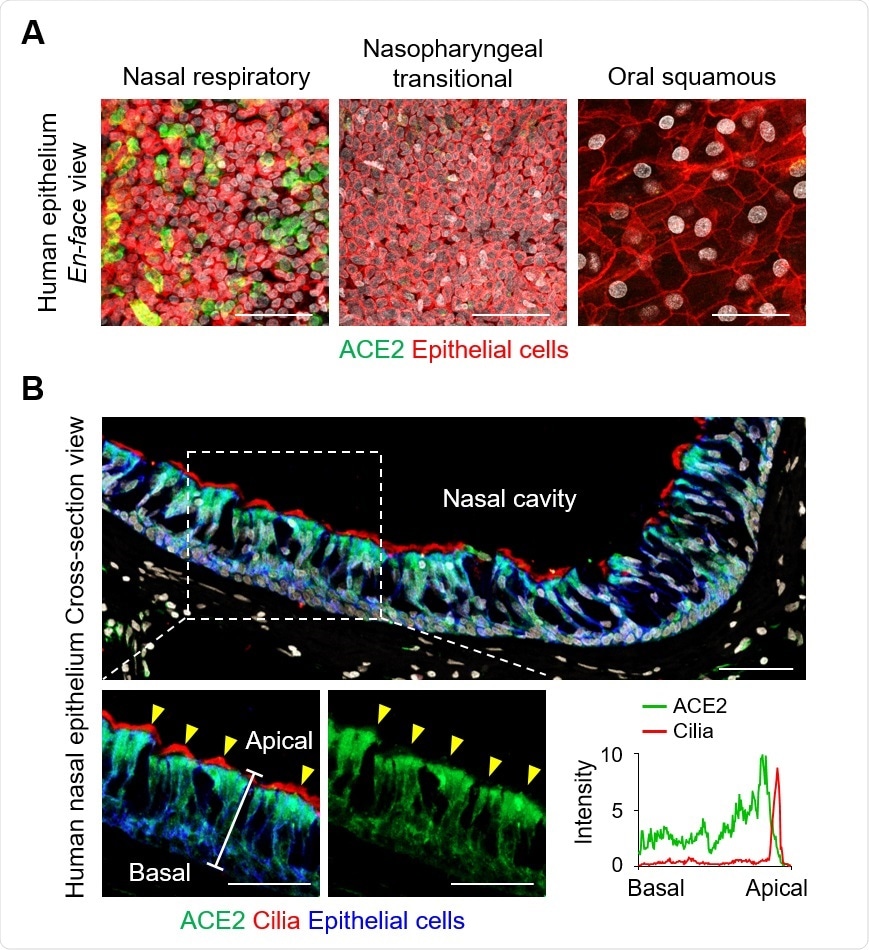Researchers have found that nasal ciliated cells are targeted at the onset of COVID-19 infection, which may open the potential to prevent infection by establishing nasal mucosal immunity.

ACE2 Protein in Nasal Cells. Image Credit: Institute for Basic Science
SARS-CoV-2 replication targets nasal ciliated cells early in COVID-19 infection
The COVID-19 pandemic has led to a surge in epidemiological studies with research efforts focusing on elements such as the mechanisms of infection, which could provide insight into developing effective preventative treatments.
SARS-CoV-2, the causative agent of COVID-19, is known to infect cells through interaction between the virus's spike protein and the extracellular receptor binding domain of ACE2.
The viral entry into the cells is completed by various proteases, allowing the virus and cell membranes to fuse. While it is known that the upper respiratory tract becomes compromised in the early infection, the exact types of the cells that the virus infects at the earliest stage have yet to be identified.
However, new research led by Director KOH Gou Young and scientists from the Center for Vascular Research within the Institute for Basic Science in South Korea, have now been able to uncover the processes involved in the earliest stages of COVID-19 infection.
Researchers accomplished this by using immunofluorescence staining (IFS) and single-cell RNA-sequencing (scRNA-seq) on the molecules involved in the viral entry process. The process allowed Koh and his colleagues to identify the viral targets at the cellular level.
Data was first collected on the presence and abundance of SARS-CoV-2 entry-related molecules including ACE2, TMPRSS2, and FURIN on the surfaces of various types of cells in the nasal epithelium. Proteins were found at the highest quantities on ciliated cells, particularly on the apical, upper, sides of cells.
Next, the researchers further studied these nasal epithelial cells using scRNA-seq and visualized the cells into different clusters.
Samples were collected from 4 patients on the first day of their COVID-19 diagnosis, which was compared against 2 samples from healthy donors. It was found that the fraction of multicilial cells was greatly reduced in the samples from infected patients, while there was an increase in the secretory cells and differentiating cells.
This indicates that multicilial cells are the first to be attacked and killed by SARS-CoV-2, which are then replaced by the latter types of cells.
The study then measured the level of SARS-CoV-2 mRNA transcripts within the various types of cells.
Among all the epithelial cells in COVID-19 infected patients, 38% of the cells were labeled as SARS-CoV-2hi cells. Up to 75% of the detected genes in these cells were of viral origin, compared to less than 1% for other clusters of cells.
These findings demonstrate that these cells serve as the main factories for the mass production of SARS-CoV-2 viruses.
Developing new preventative strategies by tracking viral pathways
Understanding how viral infection occurs can provide important clues to develop preventative strategies and develop effective therapeutic agents and vaccines.
As such, the researchers then used pseudo-time-trajectory analysis to predict the differentiation paths of various cells involved during infection. The differentiation trajectory showed that SARS-CoV-2hi cells likely originated from ciliated cells.
Further analysis on the infected patients' samples conclusively determined that up to 85% of SARS-CoV-2 factories were in fact multiciliated cells.
Therefore, this study indicated that multiciliated cells in the nasal epithelium are the first cells that are targeted in the early COVID-19 infection. These findings imply that targeting these cells using specific treatments, such as through nasal sprays, can be an ideal strategy to curb COVID-19 infection in the early stages.
Indeed, studies could further examine the potential for nasal treatments to stop the replication of SARS-CoV-2 in its tracks. Future research could also aim to determine whether post-infection treatments may also attenuate disease severity and improve recovery rates.
Journal reference:
- Ji Hoon Ahn, JungMo Kim, Seon Pyo Hong, Sung Yong Choi, Myung Jin Yang, Young Seok Ju, Young Tae Kim, Ho Min Kim, MD Tazikur Rahman, Man Ki Chung, Sang Duk Hong, Hosung Bae, Chang-Seop Lee and Gou Young Koh. Nasal Ciliated Cells Are Primary Targets for SARS-CoV-2 Replication in Early Stage of COVID-19. Journal of Clinical Investigation, July 1st, 2021